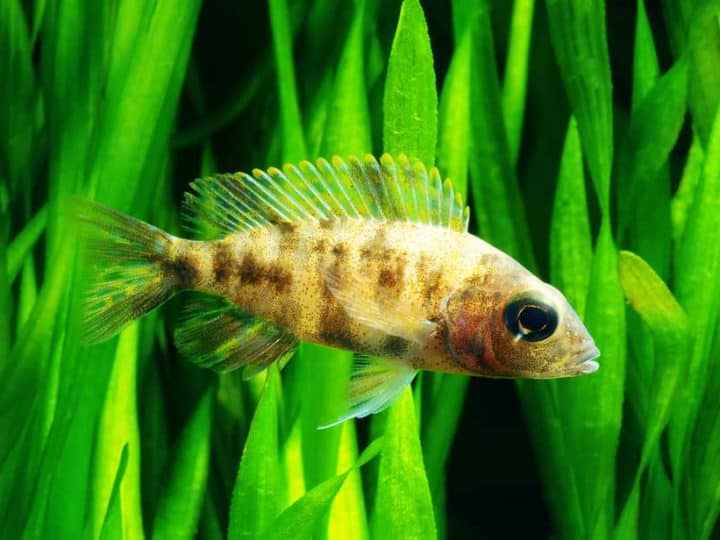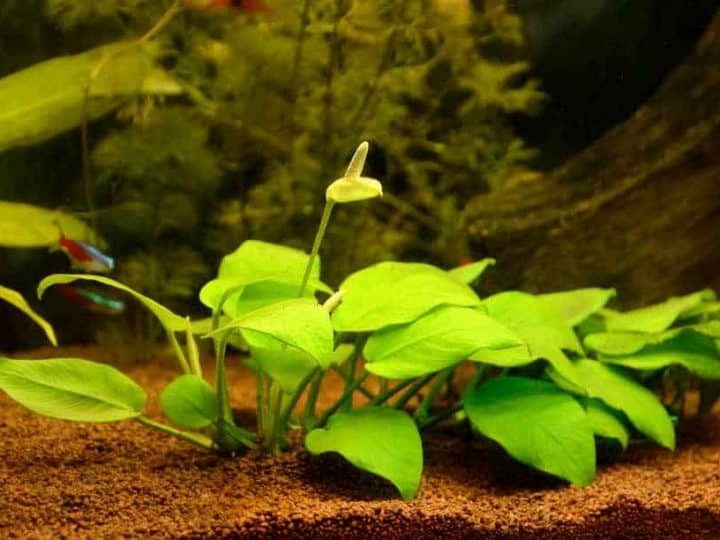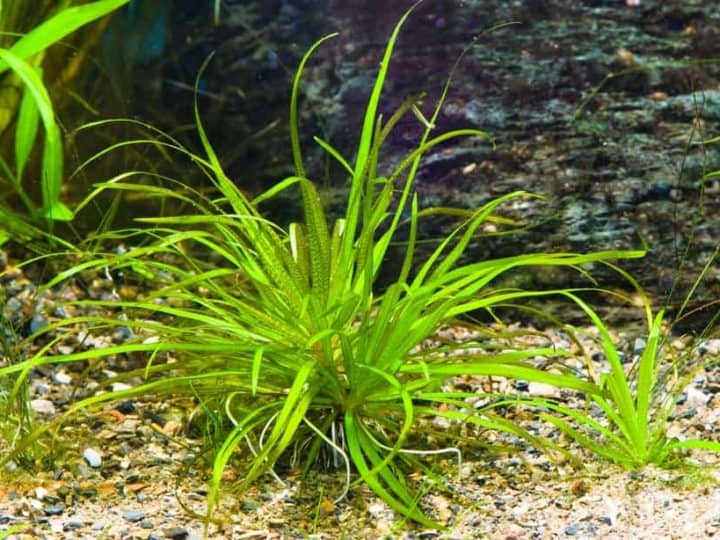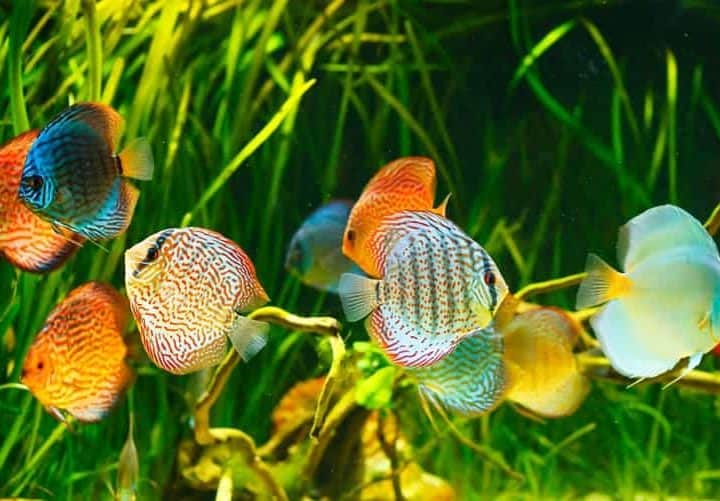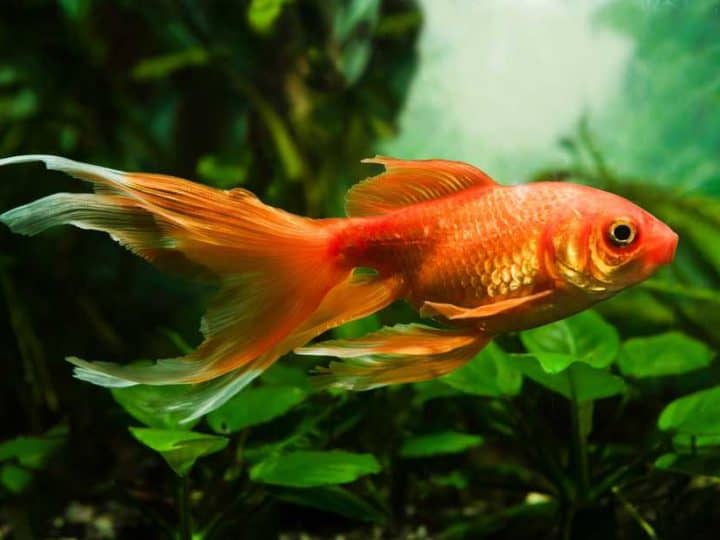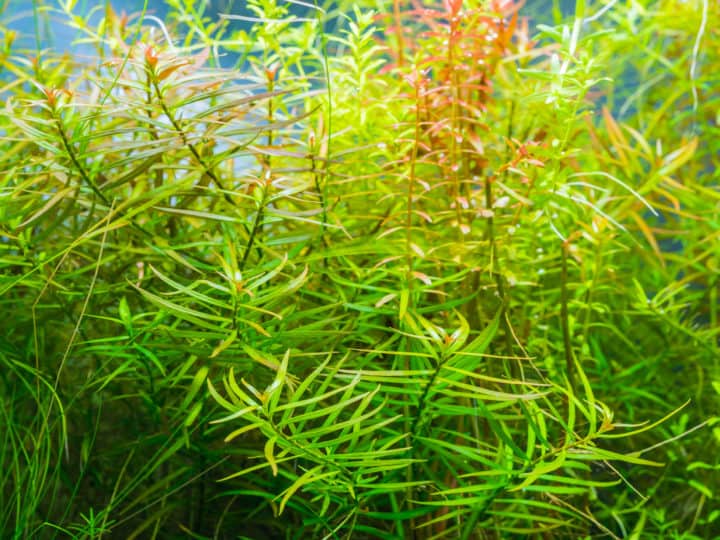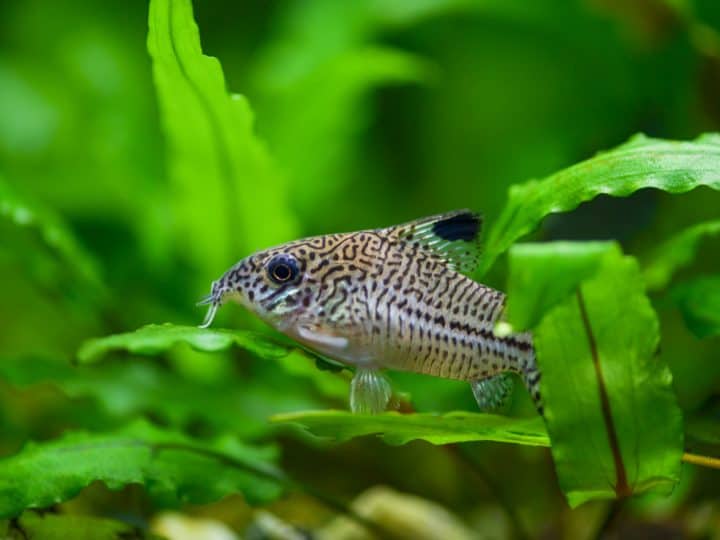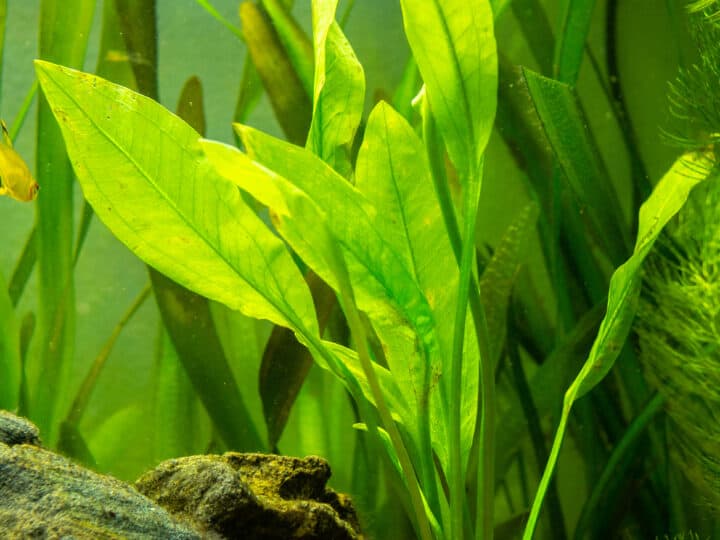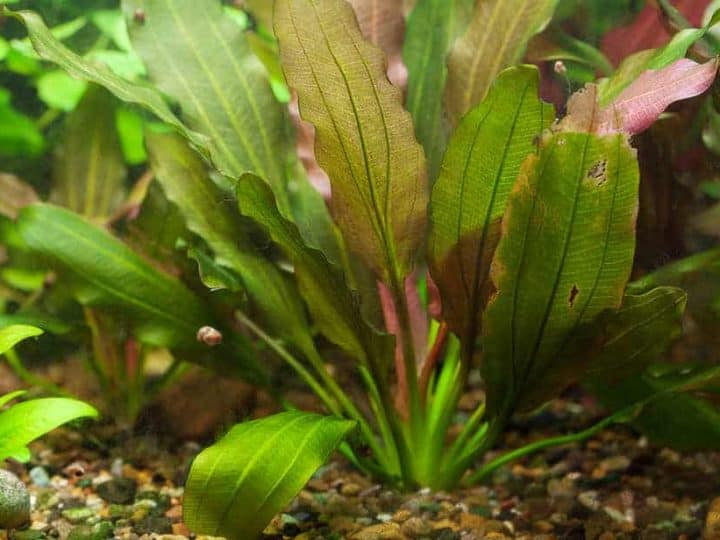Live plants are one of the most beautiful things you can add to your aquarium. I have been keeping live plants for over 5 years now, and have learned a lot through my own experiences. There are many aquarium plants that don’t need CO2, so what are they?
1. Java Fern
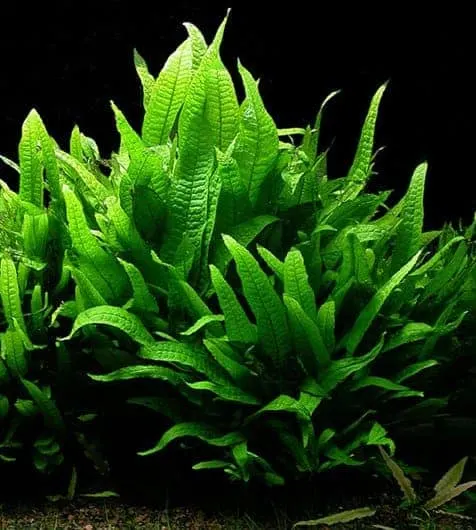
The first aquarium plant for beginners that comes to mind to a lot of people is the Java Fern. In the wild, java fern grows in shady areas, so it does not require high lighting in your aquarium too.
If the light is too bright this might even cause brown patches in the leaves of the fern, so keep the light low to medium.
Tip: Java Fern currently stands at the top of my list of aquatic plants that are suitable for beginners. Check it out here if you’re looking for some more inspiration.
One of the mistakes that a lot of people make when they first get their java ferns is planting them with their roots in the substrate. They however do not take nutrients from the substrate, and they do not do well with their roots buried. Instead, try tying them to a piece of rock or wood.
The java ferns will thrive when they are tied to something instead of buried in the ground with their roots. This also allows for some cool aqua scape possibilities.
They are slow growers and therefore do not require high nutrient levels in your water. If you’re struggling with algae problems, it’s a great idea to start adding liquid plant fertilizer to your aquarium.
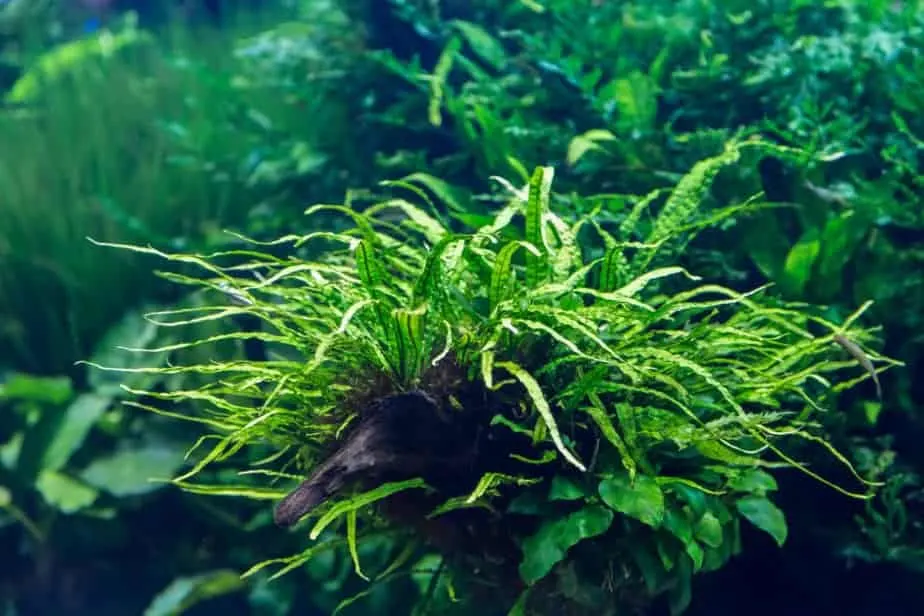
A quality plant fertilizer will make sure that your plants have access to everything they need to grow. Algae thrives when there is an imbalance in your tank and liquid fertilizer is a great and easy way to reduce algae growth.
Java fern will propagate by growing tiny plants on the tips of the leaves, which eventually will fall off. You should let the new plants grow from a while and when they are a reasonably size you can remove them from the leave to plant it somewhere in your tank where you would like them to grow.
2. Anubias
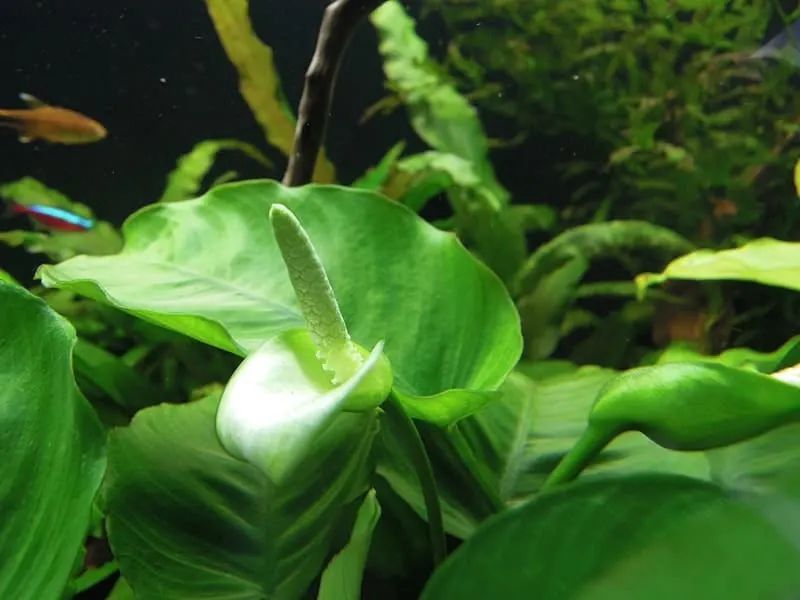
The second plant on this list is the Anubias genus. These plants are native to central and west Africa and are found in rivers and streams. They are named after Egyptian god Anubis, which is the god of the afterlife, because they are found at shady places.
This means that they do not require high lighting in our aquariums! That alone is perfect for beginners.
You can recognize an anubias plant by its dark, sturdy leaves that come in a variety of shape and sizes. The base of the plant is called the stolon, and it is important to not bury this in the substrate. It is even better to not plant the roots of the anubias in the ground but rather attach it to a piece of wood or a rock. They will thrive this way.
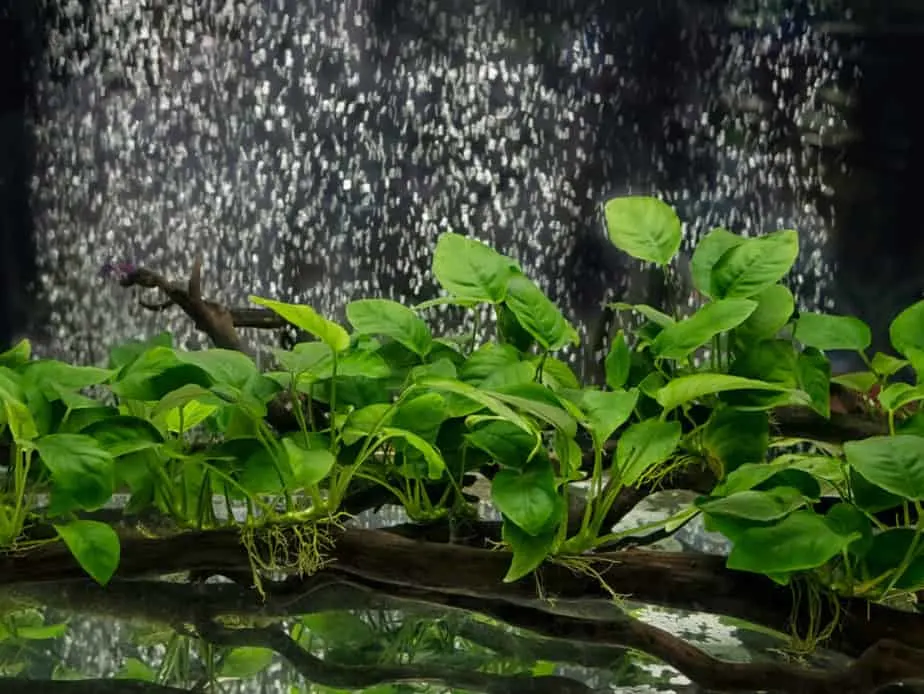
Anubias can definitely be propagated, where you can start with one plant and create many more smaller ones. If your plant grows it will gather more leaves over time. You can cut the stolon into different parts, make sure each part has a couple of healthy leaves and some roots.
To do this, take the plant out of the water and use a sharp knife such as a scalpel to cut the plant into pieces by dividing the stolon.
Different Types of Anubias
There are several different subspecies within the anubias family that are widely available and all just as suitable for our aquarium. There is a list of subspecies below, but keep in mind that there are way more!
- Anubias Afzeli
- Anubias Barteri
- Anubias Nana
- Anubias Gracilis
- Anubias Hastifolia
- Anubias Heterophylla
- Anubias Gigantea
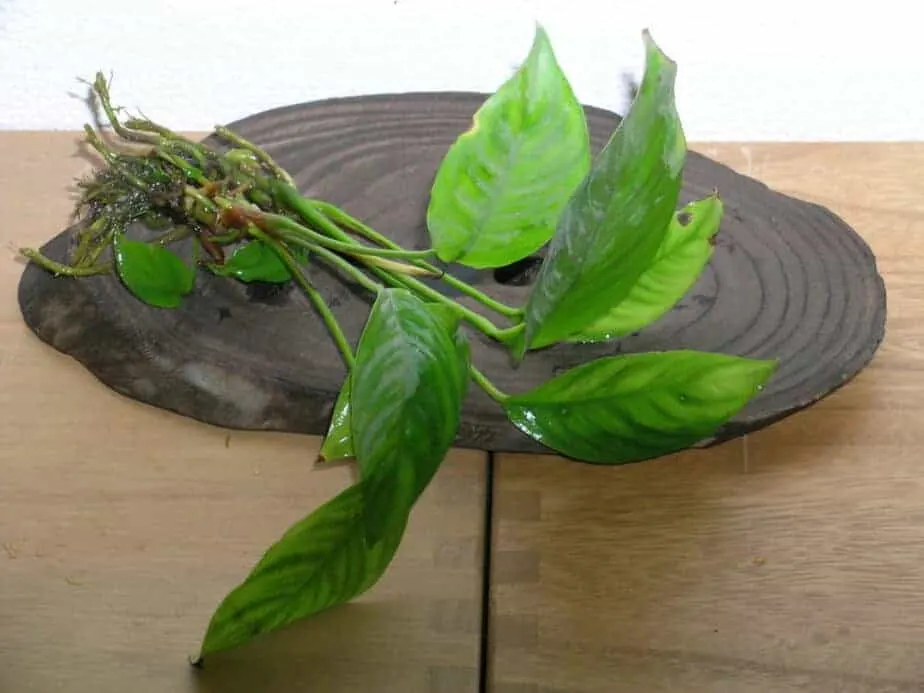
If you were to choose one of the species but you do not know which one, go to your local fish store and see which ones they have in stock. If they have several, take the one you fancy.
They will differ in size (the anubias Nana is small and the anubias Gigantea is large) and shape.
Another reason why anubias plants are this popular is because they are one of the few plants that do not get eaten by plant-eating fish like African cichlids and goldfish. The one downside to Anubias is that they tend to gather algae on the leaves due to their slow growth.
Looking for more information on aquarium plants?
In that case, make sure to check out our aquatic plants landing page. There you’ll find everything you need to make your plants THRIVE in your aquarium!
3. Vallisneria
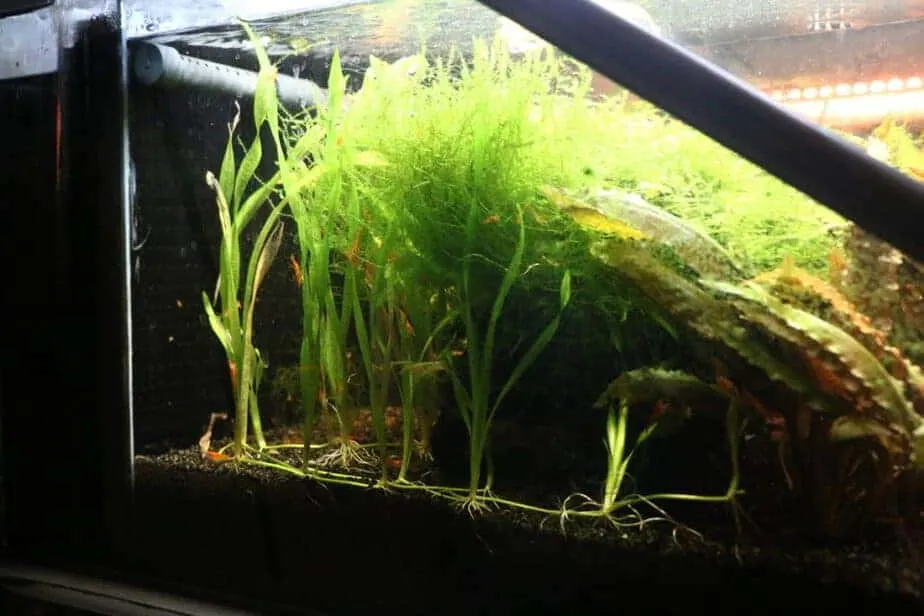
The third one on the list is Vallisneria! Most definitely not as easy as java ferns and anubias, but with the right care it is an awesome plant that will propagate quickly.
The plants root in the substrate so make sure to add some fertilizers. This can be done by a soil/substrate that contains all sorts of fertilizers but that can be rather expensive for a beginner. Something that I personally like to use are root tabs or clay balls, which can be wedged into the substrate where the roots of the plants can reach it.
This is an easy way to keep your root feeders fertilized and is especially helpful when you have a bigger aquarium as you can feed your plants on a very local scale.
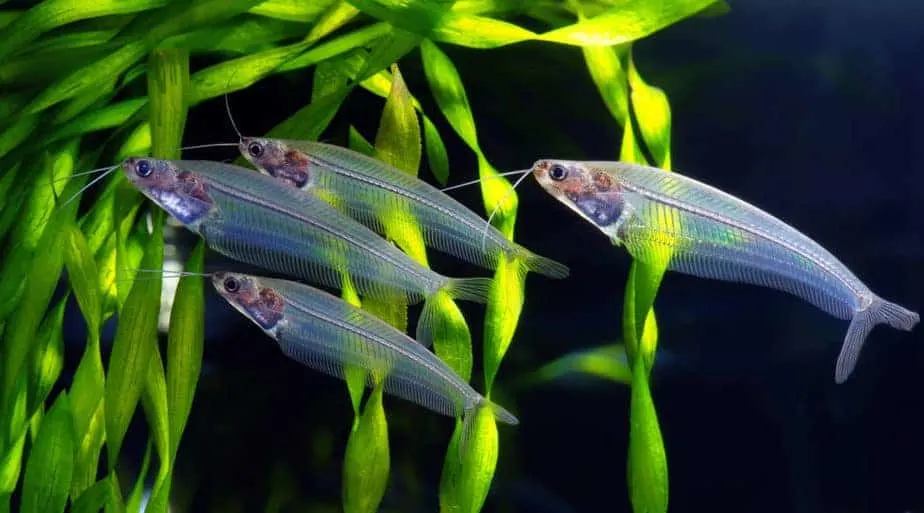
Vallisneria can also absorb fertilizers through their roots, which makes them root feeding plants. Unlike both Anubias and Java Fern, this plant greatly benefits from either a fertile soil or additional root tabs.
A fertile soil, often also called an aquasoil, is expensive and not necessary for low-tech tanks. There is a way better and cheaper solution: adding root tabs.
Root tabs are used to locally fertilize plants that need it. You simply grab a root tab and push it down in the substrate near the root of the plants. They are very affordable and I personally only need to replace a root tab every 3 months.
Check out these root tabs that are available on Amazon. Notice how many you get for the price they are offering.
Propagating Vallisneria
Vallisneria is an excellent plant to serve as a background plant. It propagates by shoots that move along the gravel called runners and daughter plants will rise every couple of inches/centimeter.
When the plant is growing somewhere you would rather not have it, you can cut it loose from the others and plant it where desired. These properties are perfect for creating a jungle for all your fish and are ideal to create ways to break the line of sight for the fish which lowers their stress levels.
This is because fish that can see each other all the time in a tank, no matter their position, some species feel threatened. A wall can block their vision and make them feel safer.
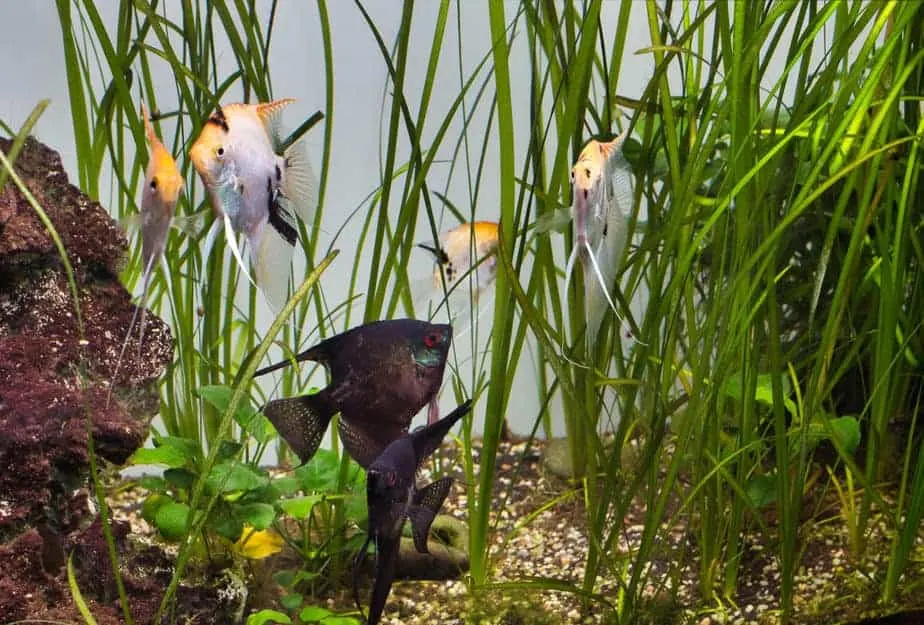
Different types of Vallisneria
Vallisneria also has multiple subspecies each with slightly different properties.
The most common type is the Vallisneria Spiralis, which grows to a size of 30 to 60 cm (12 – 24 inch), but there are smaller ones such as the Vallisneria Nana and enormous ones that are only suitable for large aquariums like the Vallisneria Americana.
The table below provides a short overview of the properties of the different species.
| Name | Length | Width |
| Vallisneria Spiralis | 30 – 60 cm 12 – 24 inch | 1 – 2 cm 0.4 – 0.8 inch |
| Vallisneria Nana | 20 – 30 cm 8 – 12 inch | < 1 cm < 0.4 inch |
| Vallisneria Americana | 50 – 150 cm 20 – 60 inch | 2 cm 0.8 inch |
My favorite fishtank products that make life easier
I am so happy you enjoy this post so far! You will also definitely like my product recommendations that will make your fishkeeping experience so much better. I’m 100% sure you’ll love them!
- Without a gravel vacuum, like one from Aqueon, cleaning the substrate of your tanks is near impossible. Whenever I want to remove some of the sunken detritus from the bottom of my acrylic tanks I’m happy I’ve got one of these.
- It’s no secret that I do not like nutritious aqua-soil. It makes a mess and only works for a given amount of time. Instead, I always use a liquid aquarium plant fertilizer. Everyone who keeps live plants needs it, it’s not that expensive and makes your plants grow better.
- I love keeping plants, but planting and reorganizing my aquarium was difficult until I got a set of these tools. It’s much easier to plant any kind of plant compared to using my thick fingers.
- Ever since I’m able to accurately test my water parameters, including the pH level, keeping fish became less stressful. Before I was always stressed that my water parameters were wrong, but with a kit such as the API Master kit, I can measure this. It really is essential to successful fishkeeping.
- The more you know about your aquarium, the better! Temperature is crucial for the health of your fish. A thermometer will also show you whether your heaters are still working correctly. It will give you more insight and more peace of mind. It’s an easy way to ensure that you’re providing your fish with the tropical temperatures they need.
4. Moss
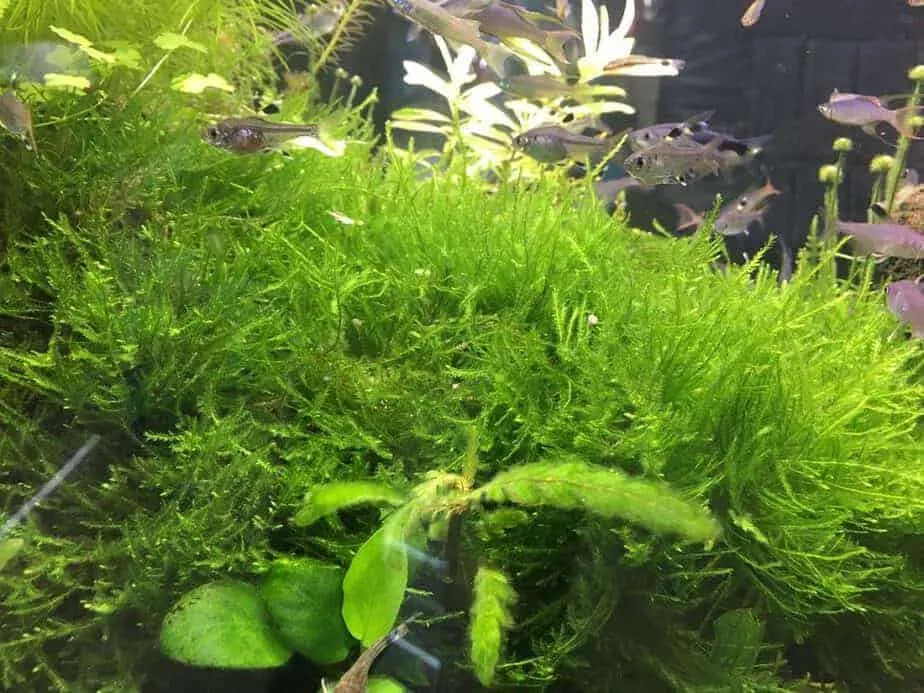
Moss is perfect for beginners and just as beautiful for the experienced aquarium hobbyist. It does not matter how much experience you have under your belt, there is always room for moss in our aquariums. There are different types, but the most popular by far is Java moss.
Java Moss
Java moss can grow in our tanks under a wide variety of circumstances. They can tolerate temperatures from 10 to 30 degrees Celsius (59 – 86F) but do best in water temperatures from 20 to 25 degrees Celsius (68 – 77F).
They will survive in low and high light intensities. A higher light intensity will make the moss grow more dense, and a lower light intensity will make the color of the moss a tad darker.
“Planting” Java Moss
Unlike plants, Java Moss does not have roots that it can use to establish itself in soil. However, the moss is perfectly capable of attaching itself to any kind of surfaces.
You can attach your moss to rocks, wood, walls, substrate and even the filter to cover it up. That is why it is so popular for us hobbyists that like to aquascape (read: gardening under water).
All it takes is some fish line or some other dark thread. There are also different kind of glues that can be used, but you have to make sure it does not harm your aquatic life.
I always prefer to use fish line. After about a month you can even remove the wires that once held it in place, because it has attached itself to whatever you tied it to. Sure, some CO2 may benefit this plant, but it’s really not necessary.
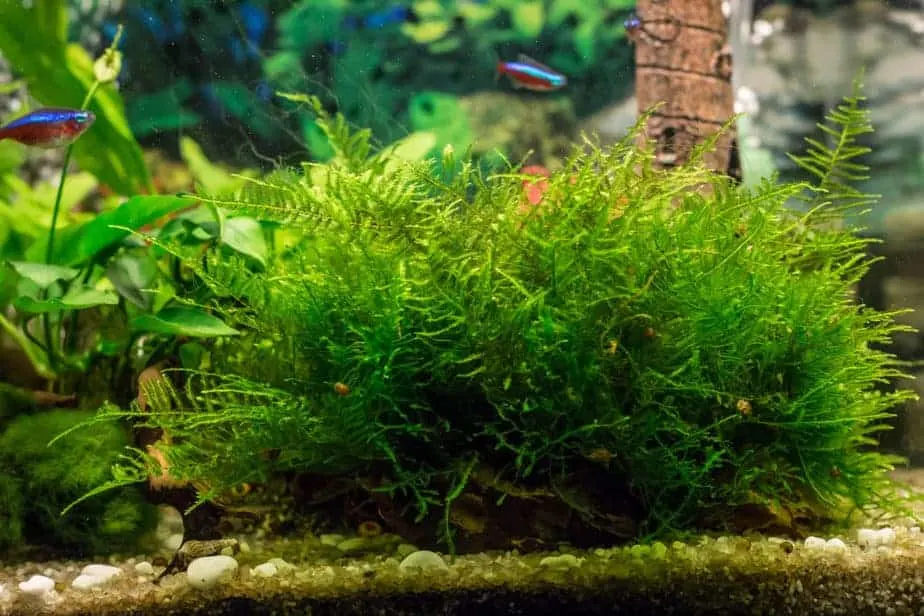
Care for Java Moss
Taking care of your java moss is extremely easy, all it requires is a pair of scissors (and you can even pull it apart so the scissors are not even a requirement). When there is too much light in your aquarium (or there are other reasons why you might experience algae issues) the moss can be filled with unwanted algae.
My solution to algae in moss is pulling the moss apart and re-attach it as a thin layer to the desired surface. When you made sure to tackle the cause of the algae bloom, the moss will continue to grow.
Moss is one of the few plants you can order online and get delivered straight to your doorstep. Once you get it you’ll probably be shocked for a second or two because you’re only receiving a small amount.
However, if planted and fixed to a part of the hardscape in your tank it will soon grow to be more.
5. Cryptocoryne
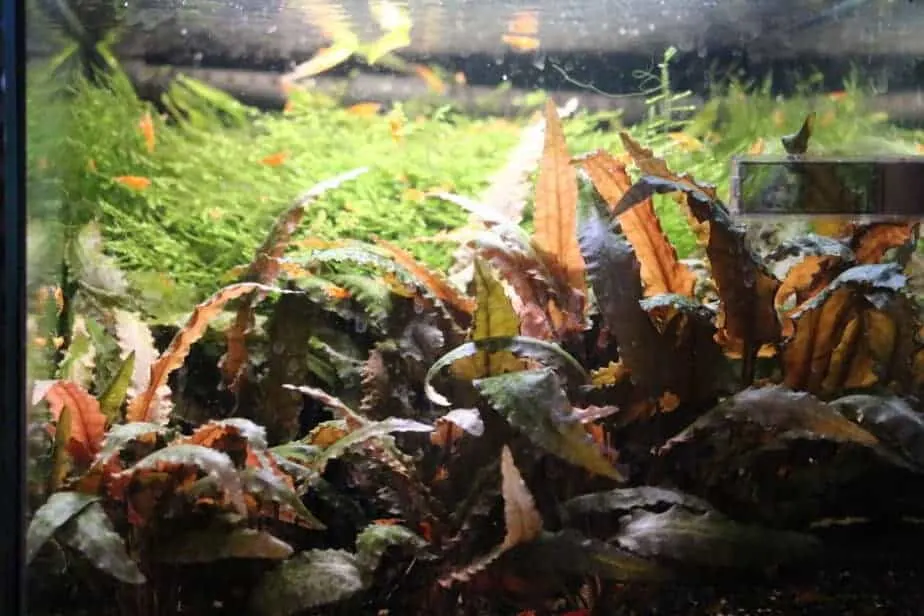
Cryptocoryne, or “Crypt” for short, is a genus of plants that are and have been extremely popular in the aquarium hobby for a long time. This is because they are low maintenance and do not require high lighting.
Different kind of Cryptocoryne
The beautiful thing is that there is a lot of different kinds of crypts, and they vary in shapes, colors, and size. There are way too many to name here, but that is the beauty.
There are plants for every region of your aquarium, and there are many different color varieties.
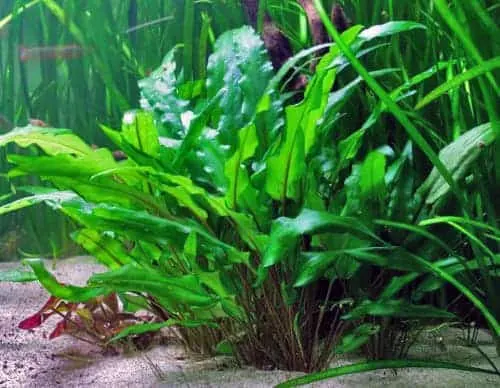
Planting Cryptocoryne
The only thing with crypts that you must know in advance is that they are rather sensitive to changes in the water parameters. This means that can not handle changes, so when this happens their leaves will fall off.
It looks like your crypts are “melting”. This is normal. because crypts bought in the store are often grown outside of the water.
Once they enter your tank they will need some time to shed their old leaves and grow new ones that are suitable to underwater life.
It can happen that you buy your crypts from the store, and within a couple of days of living in your aquarium their leaves fall off and the crypt melts. The number one mistake that beginners (but also experienced hobbyist) make is thinking the plant died and they remove it from their fish tank.
The plant however will restore overtime to become even more lush than before. Just make sure the water parameters remain stable.
Cryptocoryne is a root feeding plant that benefits from the root tabs we discussed earlier. I have also had success without root tabs, crypts are very hardy plants. It’s awesome how many different varieties there are.
You can basically create an entire tank with just crypts, and they’re great for water quality too!
6. Amazon Swords
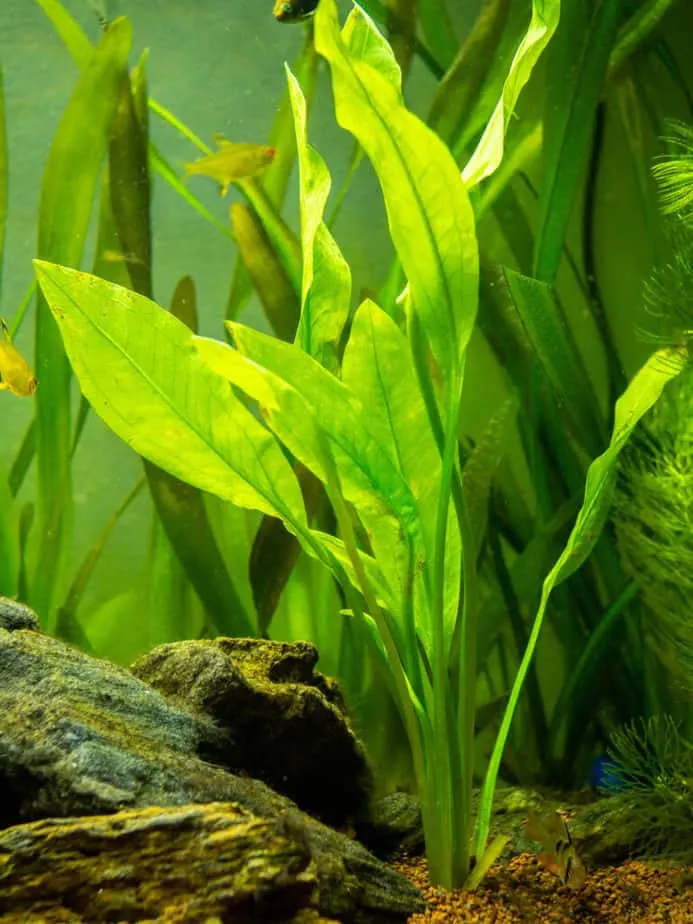
Amazon Swords are beautiful lush aquarium plants that can serve as the perfect background plant, and are always worth a mention. The grow rather tall, reaching heights of around 30 cm (12 inch). This is perfect for covering filters, filter intakes and heaters in your tank.
I myself have used them in the very first fish tank I got to hide the filter intake from my canister filter.
This plant needs a lot of light, so this might not be for your tank. It needs medium to high light and does best when the lights are on for around 10 hours. Note that the advised duration of lighting is 8 hours per day.
The most common mistake people make is not allowing the plant to die back. This happens a lot of the times when you buy the amazon sword from the store, it looses its leaves over time. It can use all of its leaves, but once it is settled the plant will grow slow and steady.
The roots of this plant can become long and range far into the substrate of your aquarium. Make sure there is enough depth and your substrate layer is thick enough.
Also, this plant is a root feeder so root tabs or a substrate with a lot of nutrients will serve the plant well.
When planting the plant, make sure not to bury the crown (where the leaves start) of the plant. This needs to be above the surface of the soil.
7. Water Weeds (Elodea)
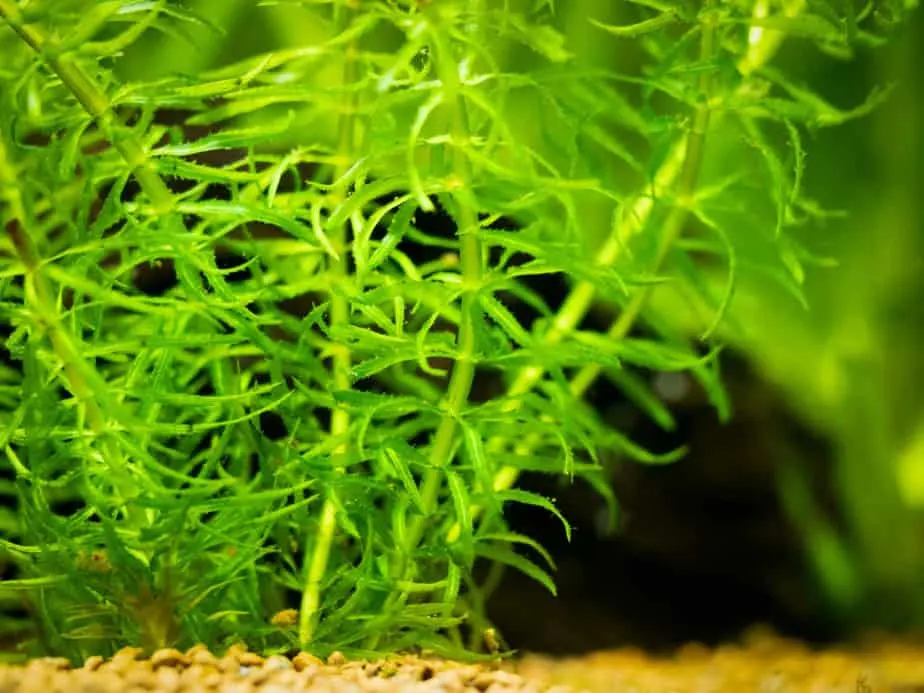
An amazing stemplant that I can highly recommend to all beginners is often called Brazilian water weeds. Actually, it goes by many names: Anacharis, Elodea or Elodea Densa.
I have managed to grow this plant without CO2 quite easily. As soon as you start adding CO2, it really takes off. The plant is easy to propagate and overall a great addition to any tank.
To get a lush appearance, combine a bunch of stems like a bouquet and push them down into the substrate. You can also let them float around the tank freely.
8. Bucephalandra
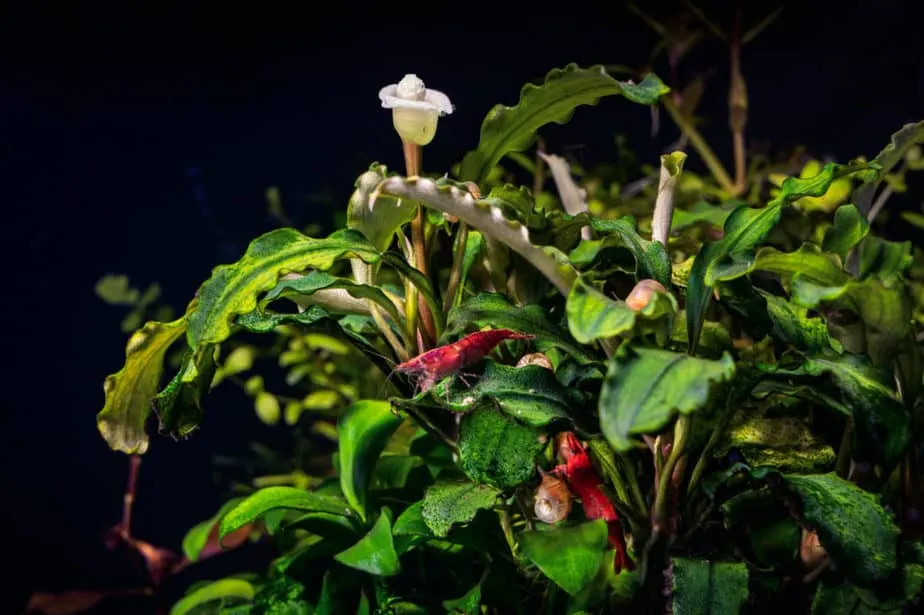
A relatively new plant is called Bucephalandra. The plant is not new, but it has not been widely available to buy for very long. I am glad most stores carry this plant in their product range. It’s beautiful for many reasons.
Bucephalandra grows rather slowly. It has similar care requirements as Anubias plants. Low to moderate lighting and little additional fertilizer.
This plant grows quite nicely in an aquairum without additional CO2. Although you have to have patience.
9. Dwarf Sagittaria
One of the easiest carpeting plants is called Dwarf Sagittaria. It is one of the few plants that you can grow on the bottom of your aquarium without CO2.
Although it is possible, it does not mean it is easy. For the best results I would recommend a nutrient rich aquarium soil. This way, the plant gets as much nutrients as possible.
This will result in slow but steady plant growth. Dwarf sagittaria looks awesome, so if you are interested I would give it a go.
10. Hornwort
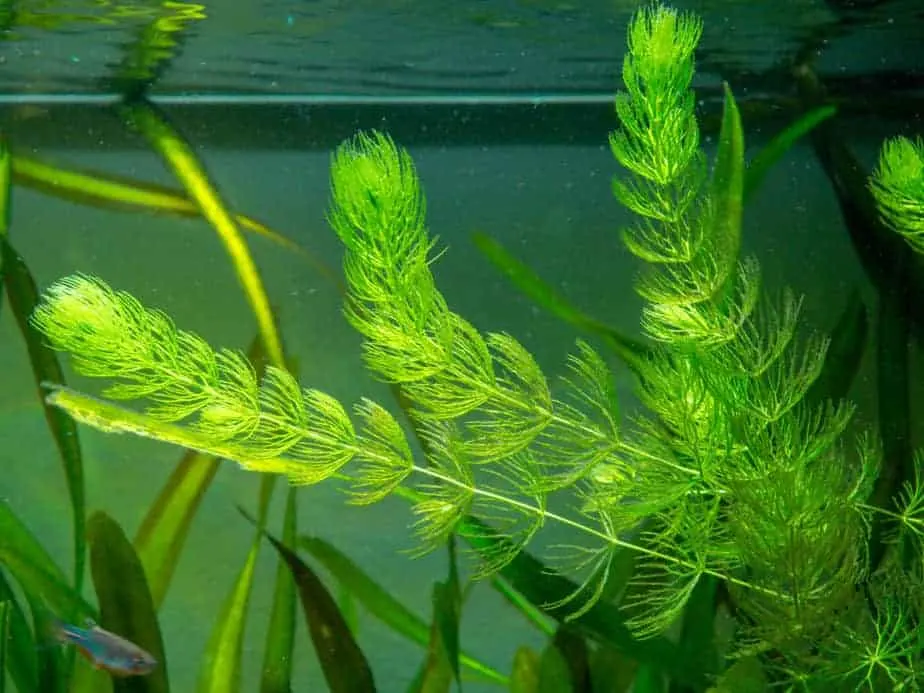
If you’re looking for strong plants that can take a beating, go find Hornwort. This plant has been found on all continents except for Antarctica.
That’s an insane achievement!
It can withstand so many different environments that it is bound to do well in your aquarium. CO2 or no CO2.
I personally have grown Hornwort and I loved it. If you hold it in your hand you will be surprised how sturdy the leaves are. They are quite pointy actually.
11. Hygrophila Polysperma
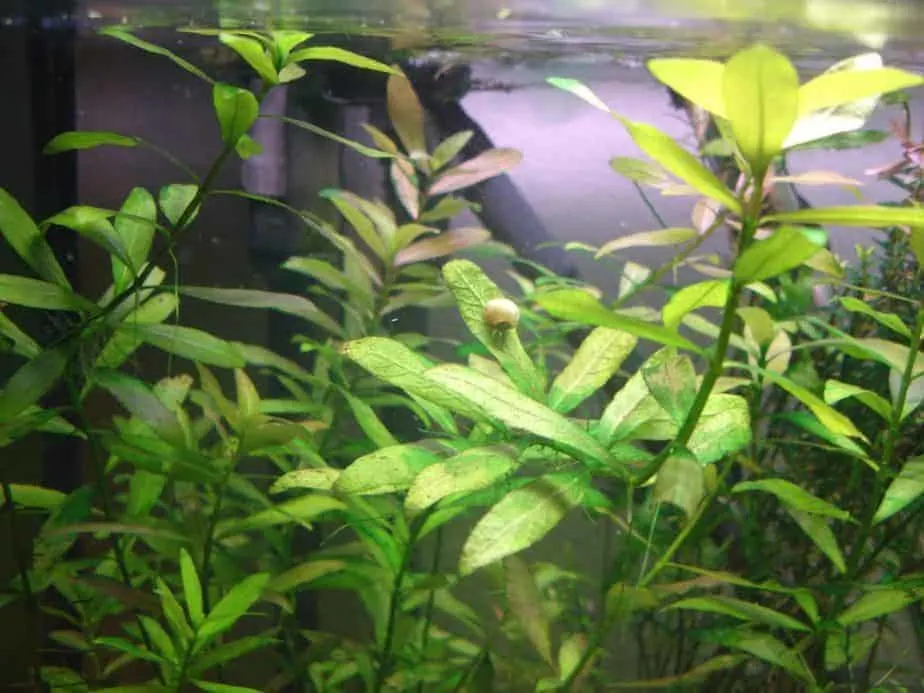
One plant that has been around for decades in the aquarium hobby is called Hygro. That’s short for Hygrophila Polysperma. Here in the Netherlands it is known as Belgian Greenery.
I got this plant from my grandfather, and it immediately started growing in my tank. I was not adding any additional CO2.
Overall, this is a great plant. It grows weird though. It shoots out new stems in all directions and all over the place. Not a very orderly stem plant.
12. Water Wisteria
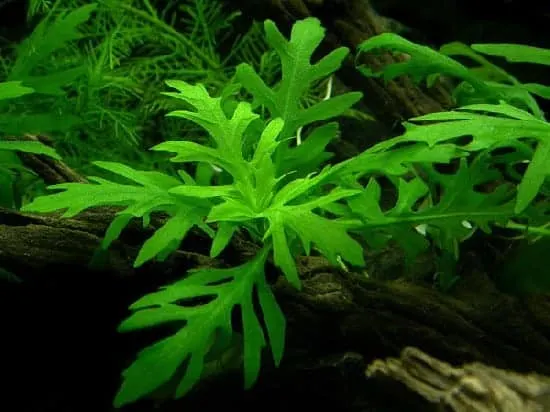
Water wisteria is the common name for Hygrophila Difformis. It indeed is a different variation of Hygrophila. However, the structure and behavior is completely different.
Water wisteria is a stemplant that can do well in tanks without CO2. If happy, it grows quite large. It needs quite some fertilizer, so make sure to add this.
Water wisteria is a common plant in Dutch style aquascapes. They are often used to create “roads” of plants.
13. Ludwigia Repens
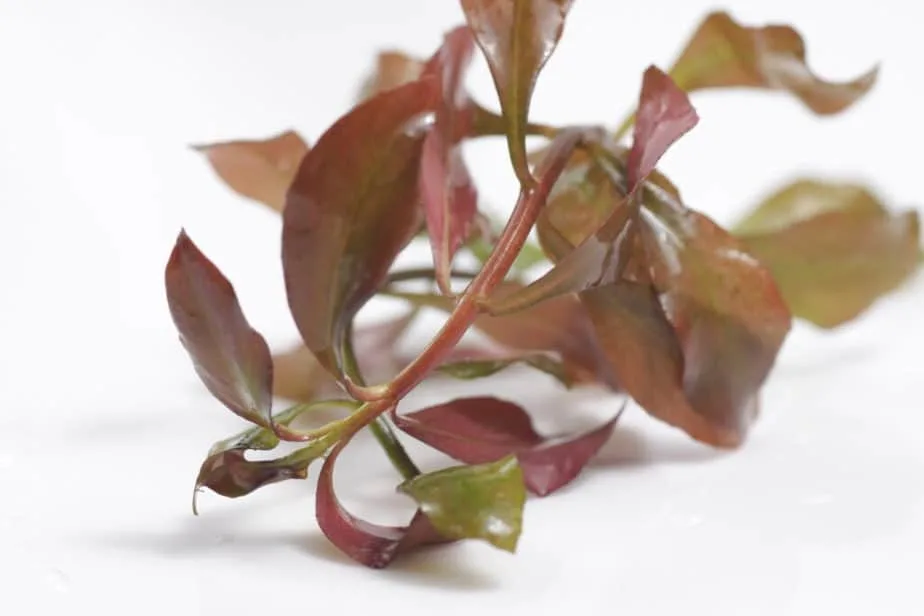
Ludwigia Repens is a very popular stem plant. It has a nice red color if there’s enough iron in the water. It can also be green in other situations.
I have kept Ludwigia Repens for a long time. Overall it was a good experience. It grows at a decent speed.
It likes moderate lighting conditions. My lights were too bright, and it actually slowed down the growth. It did not want to go up so it grew sideways.
14. Brazilian Pennywort
A plant of which I have yet to find a proper image: Brazilian Pennywort. If you have this plant in your tank and want to send me an image, I would love that. You can reach me on Instagram or through this website.
For now, you can check out this video.
What’s nice about this plant is that it does not stop growing once it hits the water surface. It just keeps on going.
I have seen a friend grow this plant in his aquarium that was not running any additional carbon dioxide. It did not do too well, but it managed to survive. Over time, it grew.
Make sure to add enough fertilization and ensure enough light. If light and fertilizer are good, this plant will start to show itself.
15. Water Lettuce
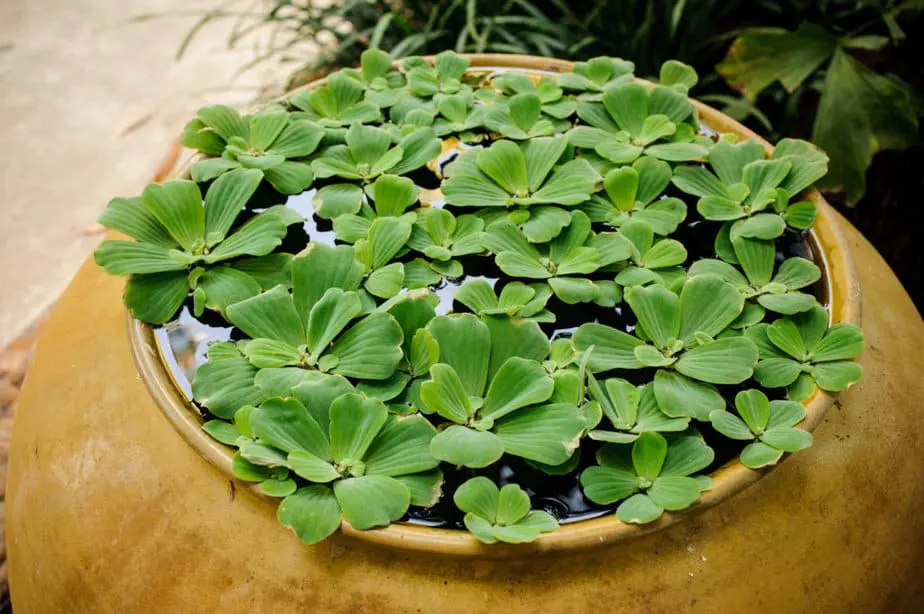
A rather large floating plant that you can add to your tank is called Water Lettuce. I believe the scientific name to be Pistia.
It might not be suitable for your aquarium due to the size. That’s understandable, as healthy water lettuce can grow to the size of a hand. The smaller onces are nice though.
The roots of the water lettuce can be rather long (up to 4 inches) so you need a large tank. Your fish will love floating plants. It provides them with shelter and a sense of security.
16. Water Spangles
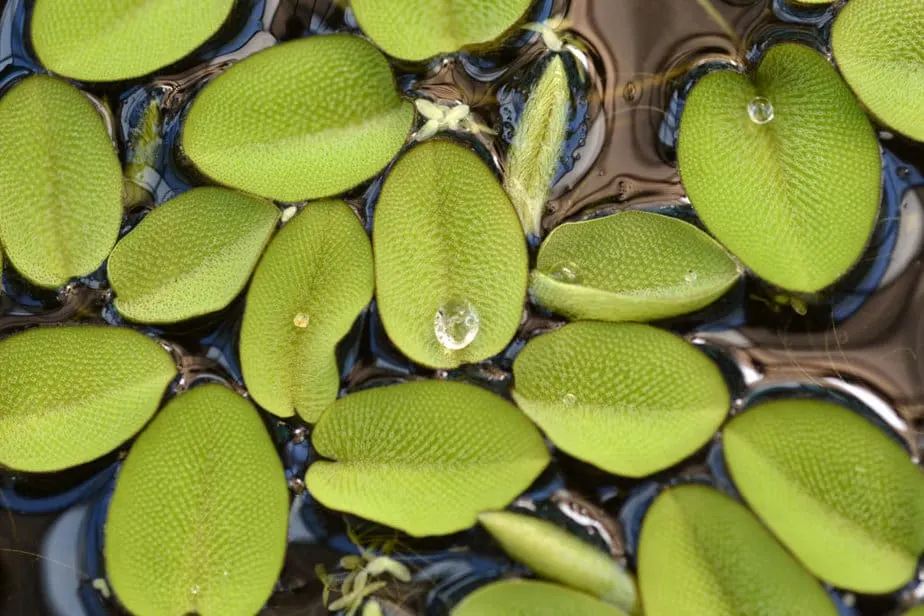
A much better alternatives could be Water Spangles. The scientific name is Salvinia.
It’s much more suitable for smaller aquariums due to the smaller leave size. The leaves are about 1 inch (2.5cm) in length max. This is the long side of the leaf.
Water spangles is my favorite type of floating plants. I have very good experiences with them. They are the perfect size, because if you go smaller it starts to become challenging. Duckweed for example is very hard to remove from your aquarium.
17. Marimo Moss Balls
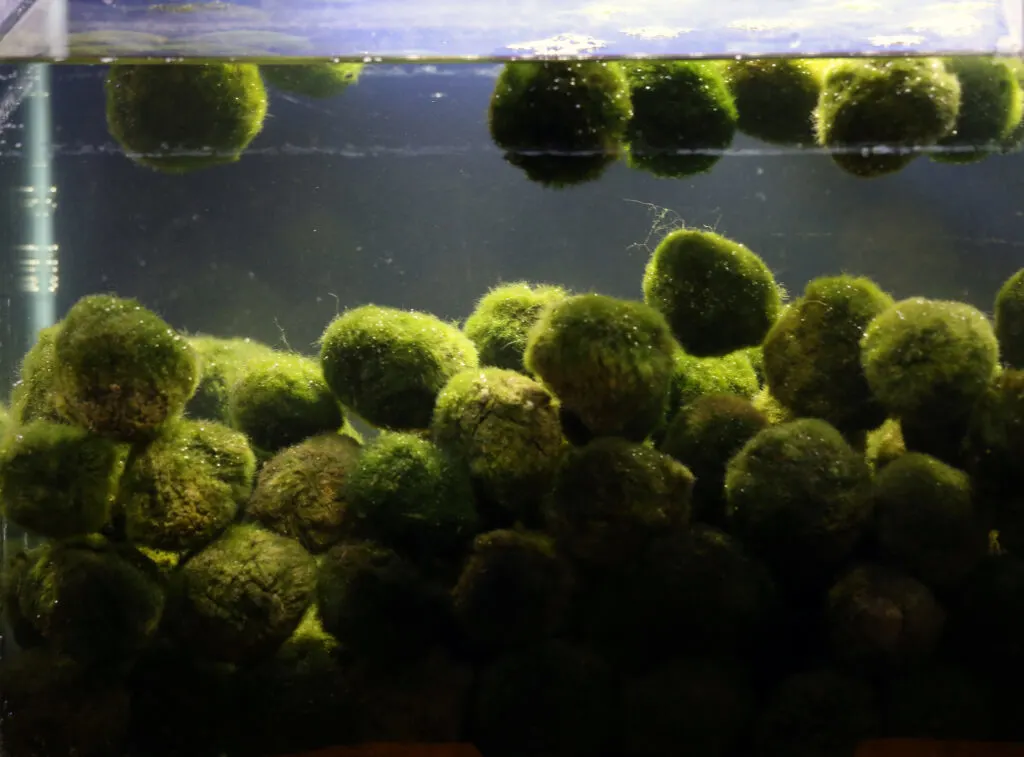
Marimo moss balls might be the easiest aquarium plants on the planet! They are clumps of moss (actually some form of algae). The only have one care requirement:
Turn them over every once in a while. This way all the sides get enough light.
There is no doubt that these plants can do well in tank without CO2. They are not going to propagate. But they are going to clean the tank and stay nice and green.
If you have snails or shrimp, this plant is even better. Especially shrimp love to sift through the hairy sides of the moss balls.
18. Red Tiger Lotus
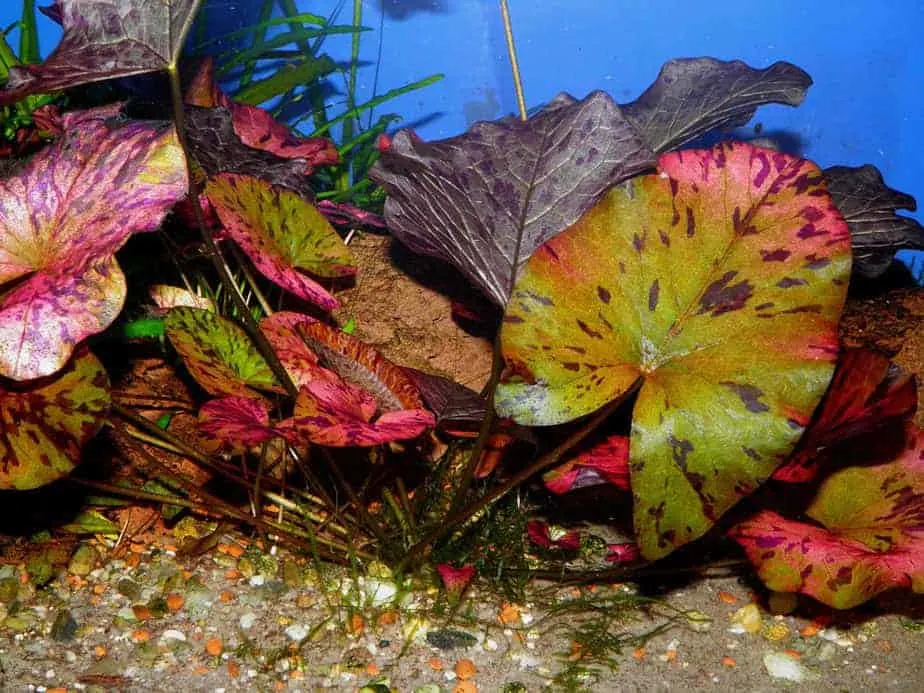
A rather ugly image of a beautiful plant. The Red Tiger Lotus is a bulb plant that shoots up runners towards the water surface. It will grow lily pads in your aquarium!
If you’re lucky, this plant will even flower in your tank. Red Tiger Lotus flowers at the water surface, how cool is that?
This plant goes way back. Decades ago, when the choices regarding aquarium plants was shorter, this plant was already around. It is quite an easy plant.
It heavily relies on its roots for nutrients, so I recommend adding root tabs or buying aquarium soil.
19. Moneywort
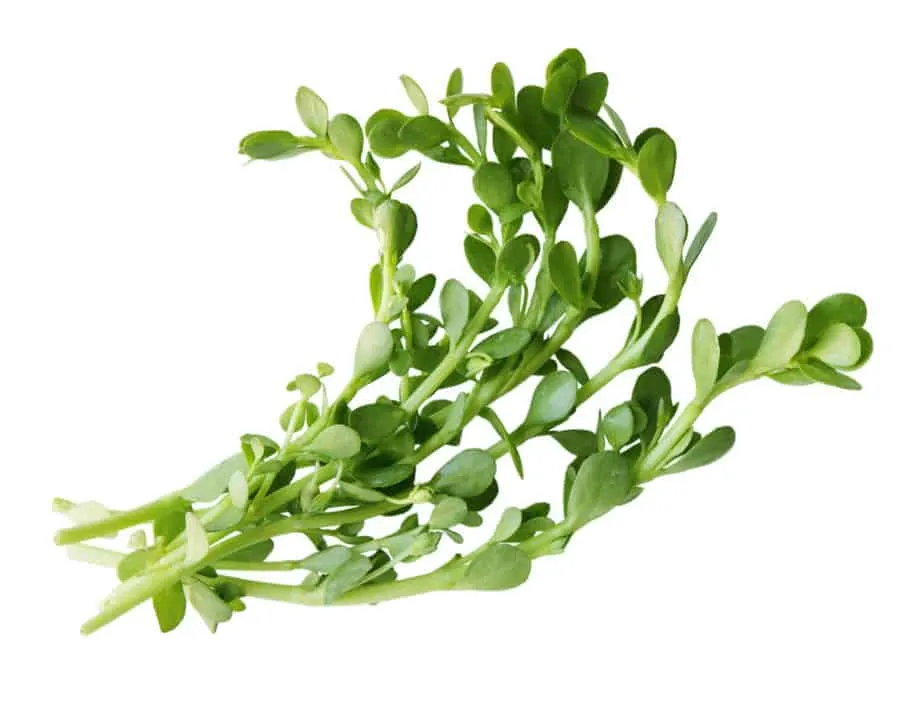
Bacopa Monnieri, the scientific name for Moneywort, is a popular plant. I myself have only grown it in a high-tech setting with additional CO2. However, it should also grow without injecting carbon dioxide.
Moneywort is one of my favorite stem plants because of the thick green leaves. Also because of the weird smell if you rub your fingers over the leaves. Very distinct. That’s because it actually also is some kind of herb.
What’s interesting is that this plant also has the tendency to grow out of the water. If it reaches the surface it will keep on growing.
20. Micro Swords
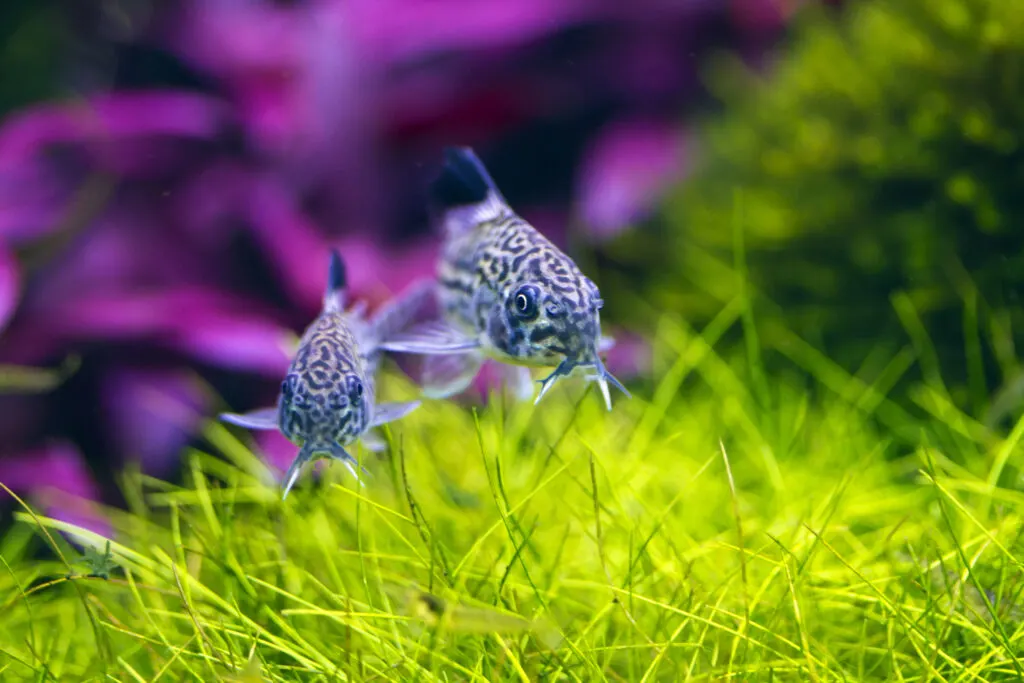
Another popular choice is the Micro sword, or lilaeopsis brasiliensis. It can be found in most pet stores today though it may be under a different name, such as Brazilian micro sword, micro sword grass, carpet grass, or copragrass. It’s best as a foreground plant.
In a tank with optimum conditions, the Micro sword can grow to about 2 to 5 inches in length, resembling a plush dense grass that corydoras can get into and hide around, as well as look for food.
It’s a light and airy plant that prefers water temperatures between 70-82 degrees Fahrenheit, fairly warm just like the corydoras like it.
To conclude
There are a lot of possibilities when it comes to beginner aquarium plants and with all the options you can let your imagination run wild! Let me know what you thought of the article, comment below. You can subscribe to my newsletter where I will update you every once in a while with new articles on super relevant information for our hobby.
References
Chapter 2 anubias photo 1 owned by Tocekas licensed under CC3.0
Chapter 4 moss photo owned by Ranjith-chemmad licensed under CC 4.0
[1] – Photo owned by Tommy Kronkvist licensed under CC 3.0

